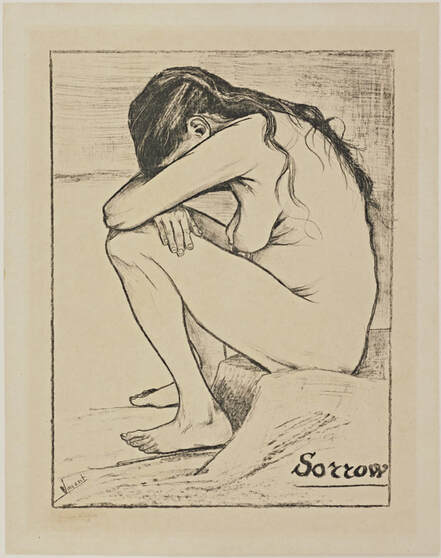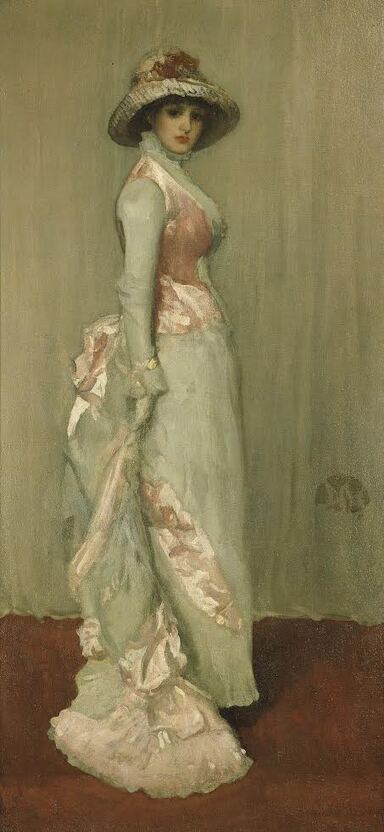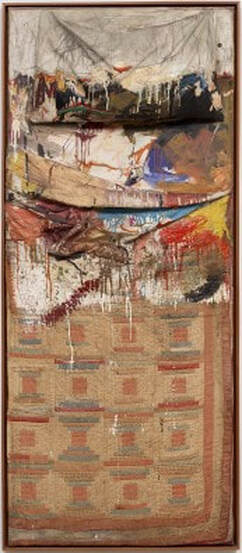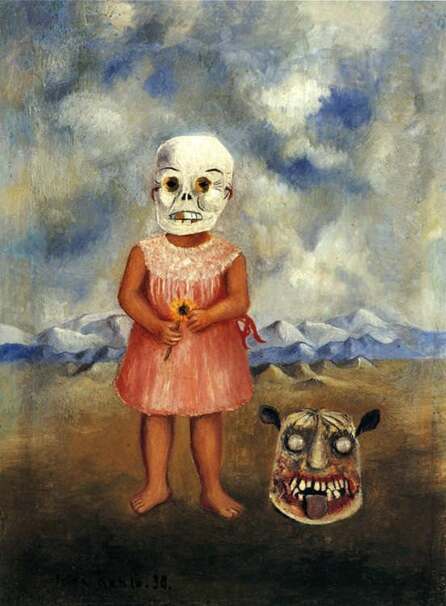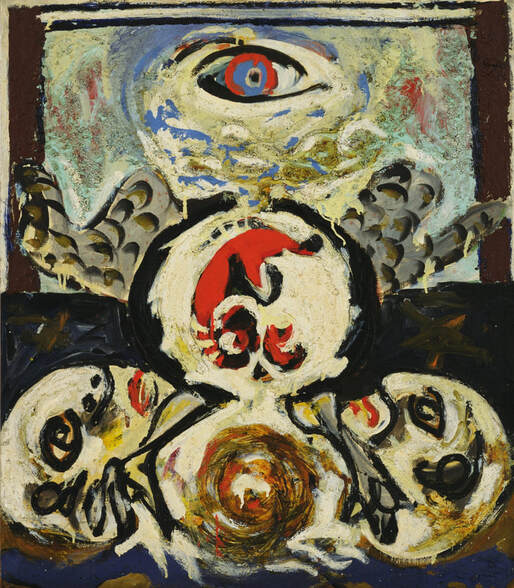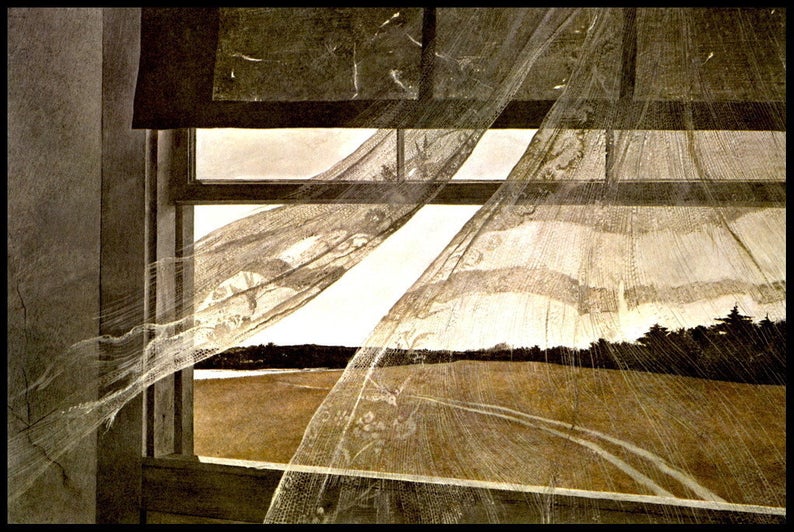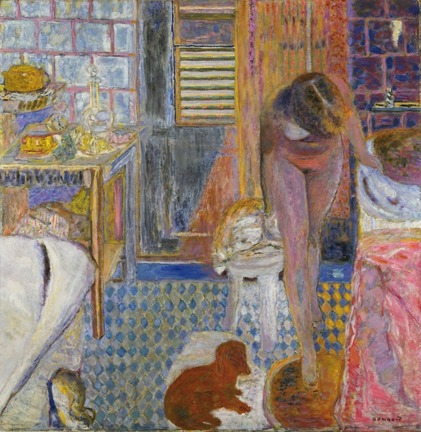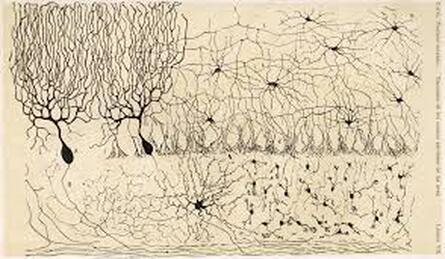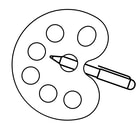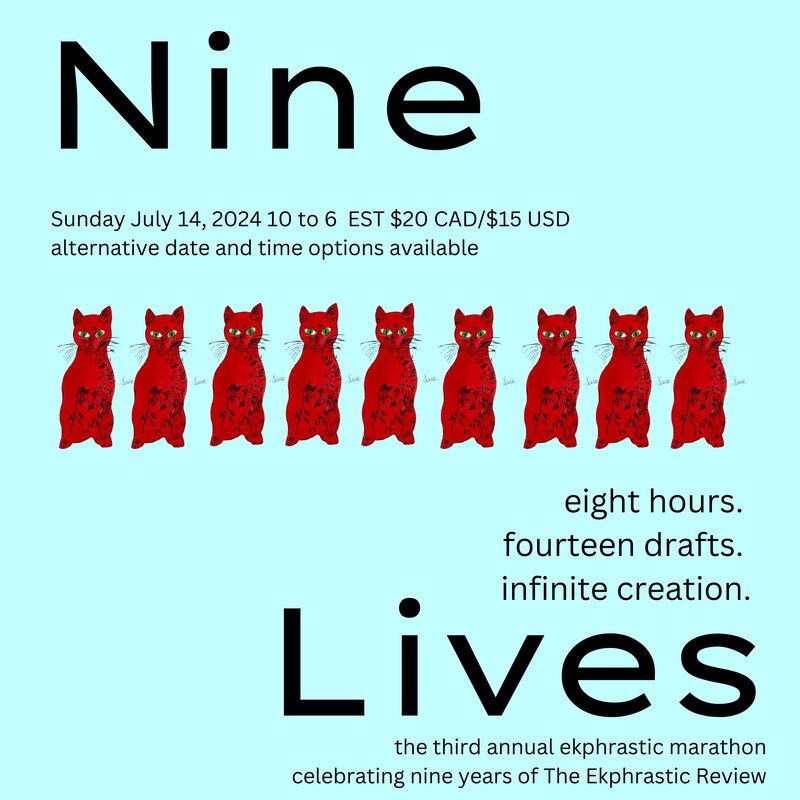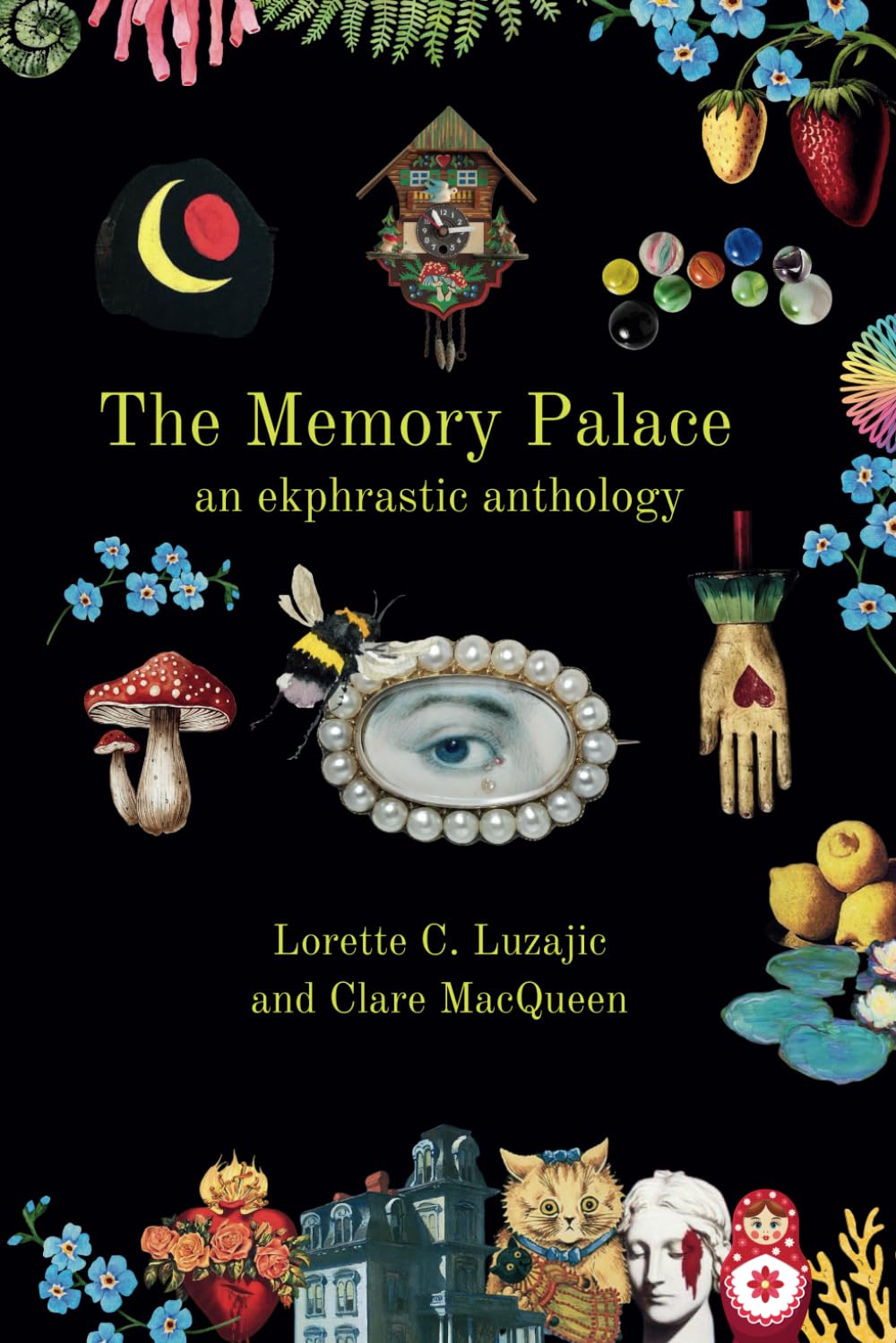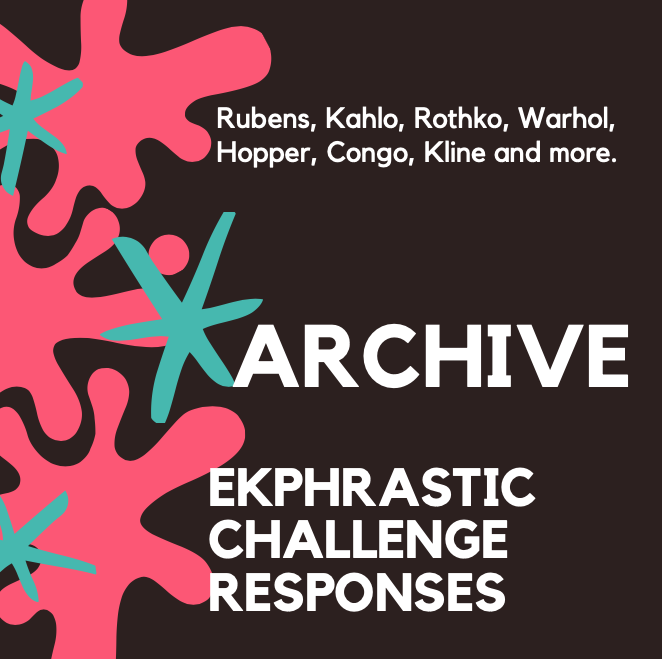|
A Well-Regulated Society “If our society were pure and well regulated, yes, then they would be seducers; but now, in my opinion, one may often consider them more as sisters of charity.” Vincent van Gogh There is no room for you at the inn. Or in the stable, for that matter, where horses break the air with their woolen breaths and shuffle in the mud. When you were a child at the orphanage a nun wore a pouch of coins at her waist and it rattled like music when she walked. Mornings, you wake under a bridge or behind a shed. Stone on bone, pressed cheek to cheek in your sleep. The walnut tree on the hill, the rough grass under you, carve their lines of bark and blade into your skin beside a fallen wood fence. At the seashore you watch sky and sea merge, the horizon blur. You are pregnant with your second child. When the tide recedes it leaves small bodies in the sand, a shell, kelp, a rotten log. Unlike water they stay still. You are coral with no tentacles. Men slide right off when finished with their anchor, their brief respite. Is it grace to give someone all they want and nothing more? You smoke a cigar in front of the fire. Peel potatoes. Mend a bonnet. These things fill hours, but your sorrow-- it is a bone in your body that connects to the others, allows the skeleton to work. You pose for him and you create edges, your body speaks its shape. Rock and flesh, little else. A portrait made still life, your body an apple on a table. During dinner he cuts your daughter’s food into small portions for her. You cannot look him in the eye. Your daughter plays with beads on the wood floor. She touches one and it rolls like a galloping wild animal out of the room, out of sight, as though it has been reborn into a life we cannot see, and have no reason to believe in. Kassandra Montag This poem first appeared in Prairie Schooner. Kassandra Montag grew up in rural Nebraska and now lives in Omaha with her husband and two sons. She holds a master’s degree in English Literature and her award-winning poetry and short fiction has appeared in journals and anthologies, including Midwestern Gothic, Nebraska Poetry, Prairie Schooner, and Mystery Weekly Magazine. After the Flood is her first novel.
0 Comments
Whistler’s Harmony in Pink and Grey: Portrait of Lady Meux Valerie Susan Langdon (1847-1910), a banjo-playing barmaid/actress, secretly married Sir Henry Meux, a wealthy London brewer and baronet. The soft gray background curtain sets the scene. Downstage is Lady Meux, in afternoon dress-- Standing in profile, her face toward us—the sheen Of cool pink satin on her train and vest. Her gloved right hand rests primly at her side, The same hand kissed by rich Sir Henry Meux, Who plucked her from a dance hall. Mortified, His family shunned her when they heard the news. Yet Whistler rescued harmony in light And line, transmuting fashion into art, Wielding his brush against the social slight, Shaping the shape that helped her play the part. She stares defiantly, with velvet eyes, At anyone who’d dare to criticize. Carolyn Raphael This poem was previously published at Theodate, and in Carolyn Raphael book, Dancing with Bare Feet, Kelsay Books, 2016. Carolyn Raphael retired from the English Department at Queensborough Community College, CUNY after more than thirty years of teaching. Her poems have been published in journalsand anthologies including Measure, The Lyric, Oberon, Mezzo Cammin, and Verse Daily. She was on the short list for the 2014 Able Muse Book Award and was a finalist for the Richard Wilbur Award. She is the author of two chapbooks: (Diagrams of Bittersweet, Somers Rocks Press, 1997 and Grandma Poems—Not Too Sweet, Kelsay Books, 2017). Her two poetry collections are The Most Beautiful Room in the World (David Robert Books, 2010) and Dancing with Bare Feet (Kelsay Books, 2016). She is the poetry coordinator of Great Neck Plaza in Great Neck, New York. This involves her choosing a poem each month for “Poetry in the Plaza,” which places poems on local bulletin boards, much as “Poetry in Motion” places poems on the New York subway. She also coordinates the annual Great Neck Plaza Poetry Contest. carolynraphaelpoetry.com 1955 Rauschenberg Bed Pull on a thread and the bed unmakes itself. Tug a stitch and initiate an unquilting bee. Last night your hair fell out and scribbled all over the pillow, mouse-gray head hairs dangling white sheet threads, each hair crossing out fibres by fives. You’ve left your stingray mouth here too, its bottom lip sticked snapper red. Down the covers slide mucus blood and sunrays in a bedhead afterbirth, past sheep white as sheets against sky, wagging their shirttails behind them. You’ve made your bed now (hang it all) on the wall. What a life we’ve slept here – hair blood and sun in the sheep-blinking earth, thick and glorious in your wet-paint dreams. Lillo Way This poem first appeared in The Madison Review. Lillo Way's chapbook, Dubious Moon, winner of the Hudson Valley Writers Center’s Slapering Hol Chapbook Contest, was published in March 2018. Her poem, “Offering,” is the winner of the 2018 E.E. Cummings Award. Her work has appeared, or is forthcoming, in RHINO, Poet Lore, North American Review, New Letters, Tampa Review, Poetry East, Louisville Review, among others. Way has received grants from the NEA, NY State Council on the Arts, and the Geraldine R. Dodge Foundation for her choreographic work involving poetry. www.lilloway.com Girl With Skeleton Mask She wears her death mask the way I wear jeans. Some mornings she’s in my mirror staring back. I shoo her away. She won’t go, starts to laugh. Kenneth Pobo Kenneth Pobo has an ekphrastic book from Circling Rivers called Loplop in a Red City. His work has appeared or will appear in: North Dakota Quarterly, Summerset Review, Nimrod, Hawaii Review, and elsewhere. Bird I know you see me watching you, and still, you sit on the fence post with me just a few feet away. I rake the leaves and you watch, your head turned to the side and your eye on me the entire time. My daughter is teaching me to speak your language, millions of years older than my own. I promise to keep the feeder full of seed and the wire holder stocked with suet in every season. Lisa Stice Lisa Stice is a poet/mother/military spouse. She is the author of two full-length collections, Permanent Change of Station (Middle West Press, 2018) and Uniform (Aldrich Press, 2016), and a chapbook, Desert (Prolific Press). While it is difficult to say where home is, she currently lives in North Carolina with her husband, daughter and dog. You can learn more about her and her publications at lisastice.wordpress.com. Breathing in the Sea A visitor once ran from this room – thought she saw a ghost. I admit these frail lace curtains take on a life of their own, but I believe people carry their own ghosts with them. Been here all my life and never seen one. Everything about this house is spectral gray. New drapes would only make the walls cry out for paint. I’m content to live in the past. The fluttering flowers and birds are right pretty. Grandmother Hathorn made them. Maybe she figured they were as close as I’d ever come to a bridal veil. We redo to make do in this house. Sometimes I take a nap up here, watch the curtains billowing until they lull me to sleep. Don’t they look frothy like seafoam? Muslin would snap like sails. The sea breathes right through the lace. Alarie Tennille This poem was first published by Minute Magazine. Alarie Tennille graduated from the University of Virginia in the first class admitting women. She’s now lived more than half her life in Kansas City, where she serves on the Emeritus Board of The Writers Place. Her latest poetry book, Waking on the Moon, contains many poems first published by The Ekphrastic Review. Please visit her at alariepoet.com. Turning Colour Into Light Having not painted since the move from Boston to Berkeley move, I don’t know how to re-enter my work. Start at the beginning, I deduce, return to my first painting crush, my first artist love with whom I feel akin, French post impressionist painter-Pierre Bonnard. At Moe’s Book on Telegraph, I scan the Bonnard collection downstairs, pouring over the pages as I had done in art school. The borrowed library book, always propped up against the foot of my easel, open to a colour print that never came close to capturing the luminosity of the original, now splattered with turpentine drips in Bonnard hues. One of his still-lives could beckon me, with its shimmering colour, from across a museum. And it has. I pen poems. Flesh rainbow, an arching back across canvas like an opalescent bridge, connecting corporal form with the inner-envisioned world of ideas and spirit. Patterns and jutting edges, ambiguous red and vulva pink angle, pushing up through the corner, tightly arranged like sitar strings, a series of verticals, vibrating with colour. A bent knee, a foot extended in a marine like haze where the contours of a woman emerges from this deep Prussian blue. Leaning figure balanced on two violet legs, vanishes to a point where female figure poses beside a porcelain tub – brown in shape of dog against white. Images, hues like abalone shell reveal the shimmering interiors of intimacies, a life. This is the life I admire and desire, identifying with Bonnard’s aesthetics evident by his choice of subject matter- Marthe, his lover, in the bath, dressing at an open window, or sitting amidst a bowl of ripe fruit. His love of the intimate lives in me, too, and I yearn for the relationship they seem to share, bonded by these moments, forever captured in radiant pigment. A realization, would soon however, challenge my perception, change my course. It would pass so quietly, yet would shake my foundations. As I bend and twist at the edge of my bed, buckling my suede ankle boots, the worn post card of a Bonnard print hanging across the room above the light switch by the door, catches my eye. A revolution ensues. Everything must be reconfigured. My usual cafe will not do - too many distractions. At La Batou Evre, with its salmon pink linens and classical music wafting, a cafe where I am anonymous, a story will be conceived, gestated and birthed. Sculpting with words, at the La Batou Evre, I craft a story. Marthe and Pierre Marthe, the model and later wife of the French painter, Pierre Bonnard, was a sensitive woman. Easily offended by the vulgarity and harshness of Parisians and most people in general, she withdrew from social life. As a defense against this predisposition, she created a beautiful world in which only she and her husband lived. In fact it was such a place of refinement and simple, profound charm that Pierre surrendered willingly to her insistence that he remain home with her. He was happily seduced into her magical universe, content to render and record its moments and subtle movements. Occasionally he would sneak out to the café, the dog as a pretext, hoping to meet Matisse or some other friends. The other painters were not altogether understanding of his allegiance to Marthe and the severe restrictions on his freedom. Many gossiped that she was "unbalanced." To an artist, balance and beauty are synonymous and certainly, Pierre, a Libra, knew balance, and Marthe knew beauty – she lived in it and he lived for it. Their life together was like a brilliant gem, created and held in a masterfully designed ring, set upon a finger, perfectly contained unto itself. Their home, the centre of their life and backdrop to all events, was a cathedral of light. The dining room table was an altar, complete with goblets, wine and sacrificial flowers. The bath was Marthe’s sanctuary. With steam rising like incense, she submerged herself in warm baptismal waters, and meditation. This is where she found solace. Pierre’s painting was his favoured form of prayer- an extension of his own soul- stirrings and yearnings. So, like a devout parishioner, he portrayed her in devotion, ritually robing, anointing herself with fragrant oil, or setting the fruit offering on the table by the open window. He not only succeeded in capturing the quality of light around them, but as he created, Pierre had the wondrous ability to add to it. He was known to mutter as he worked- "It’s still colour, it is not yet light." In fact, there was so much luminosity in this place that even angels were attracted to linger. And they did. It happened at this time that I too was living in the world of spirits. It was late summer, when the air is heavy with the scent of tuberose, honeysuckle and jasmine and the garden is saturated with lustrous colour, boasting fuchsias, violets, oranges, buttery yellow, purble berry and red. Together they had morning coffee, only the sound of birds could be heard. Marthe would perform the daily bathing rites, a ceremony that could take hours, as Pierre followed with easel and pallet to worship by her side. He set up his new canvas which he had prepared the night before. This new painting seemed to compose itself with remarkable ease. Each colour mixed, resonated, shimmered and glowed like fiery embers as each stroke was gently laid against the other, seemingly effortless, yet executed with exacting intention. In spontaneous celebration of the day’s triumphant accomplishment, Pierre took his wife passionately in his arms and danced her to the feather bed in the next room. Tenderly, they made love in a rare moment of demonstrative affection and openness between them. The intensity of light was so great that late summer afternoon that I was somehow drawn down into their lives. There, for a brief moment, a beautiful few weeks, I was their union, their celestial collaboration, delicate tendrils of DNA creation. Their child. But, like the cut wild flowers on the nightstand, it wasn’t to last. It was revealed to me, shortly thereafter, that this was not my time to incarnate into human form- I was called back to the other side. I was deeply sad to leave Marthe. Although I had to abandon her corporeal body, I remained hovering near by as long as I could. Is it possible that the lost pregnancy only aggravated Marthe’s already sensitive nature, propelling her to retreat further into herself and into the rituals which comforted, soothed and sustained her? Perhaps too, Pierre’s seclusion was in part feeling responsible for her sorrow, or his own unexpressed grief and loss which kept him devoted. Perhaps he needed to connect to her and her pain in order to feel his. Sadly however, portraying his companion in those intimate scenes and exposed manner was the only way he knew to express his own vulnerability. Maybe it was really himself floating in the bathtub, expressionless, submerged in amber speckled indigo paint. Pierre accepted that this was closeness. A canvas always between them, keeping him emotionally exiled from the woman he yearned to know and, in some intrinsic way, from himself. So, despite all of Marthe’s efforts to avoid loneliness and isolation, she remained painfully alone, her partner never able to enter her world, only able to describe it in radiant detail. That which we most want is what we push away, and that which we are most determined to keep at bay, we invite in. They never spoke about the miscarriage, but I believe they both sensed my presence. I recognized myself in Pierre’s work as if he had depicted my very essence. Sometimes I appear as a vibrant violet surrounding Marthe like an aura. Other times I am the golden green ochre atmosphere in Pierre’s self-portraits. I was delighted to be recorded in their lives. Decades later, I was offered the opportunity to take earthly form. Yet, so strong were my impressions and memory of Pierre and Marthe that I awoke driven to construct a life of poetic duality, cherishing the simple pleasures, while finding the sacred in the mundane, the holy in the profane, and elevate it all. The curious revelation, sitting at the edge of my Berkeley bed, buckling my boots, was the sudden response to my direct view of a Bonnard’s print above the light switch- it was never Pierre’s aesthetic or sensual sensibilities that I had shared. But, rather those of Marthe! It was Marthe all along. How had I not see this before! As I write about the Bonnard’s, the picture of their relationship fans out before me. I cringe with embarrassment as if I have eavesdropped on a private moment, a door slightly ajar. Maybe these insights are real, or, perhaps, just the machinations of imagination. And would it matter? Such is the dynamic between fact and fiction. The metaphor, the story, is the essential, make believe. Believe and make. The intersection of art and life. My life informs my art, which informs my life in an ongoing conversation, leading me to examine my own biological parents and "this" life. Renee and Herman. Artist and Rabbi. With the same heat-sensitive lens that I viewed the Bonnards, I turn my gaze upon my blood parents. What is it to be the product of a rabbi and an artist? Like Herman Hesse’s Narcissus and Goldmund, my parents are the next puzzle pieces to understanding myself. I peek, peer into the obvious and come close to the mysteries. Sometimes I peer into the mysteries and come close to the obvious. I scrawl in the bathtub: "In this life, I must synthesize the fragmented existence of oppositions - love and freedom, reconciling desire and disappointment, creating, not just a painting, but a life- colourful, sublime, complex, balancing and transmuting tensions from the chaos, from the yearning- into light." "It’s still colour," says Pierre, "it is not yet light." As the water pours a steady stream from the faucet, I soak and float in the amniotic waters of my claw foot bath- sea salts and oils in musky, woodsy and floral fragrances by my side, remembering and reinventing my life, turning colour into light. Masha Savitz Masha Savitz has a BFA in Painting from Boston University a Masters Degree in Rabbinic Studies from the American University of Judaism. She wrote and directed the documentary RED REIGN, exposing forced organ harvesting in China from live Falun Gong practitioners based on the work of human rights lawyer and Noble Peace Prize nominee, David Matas. She contributes as an Arts and Entertainment journalist for Epoch Times. To Santiago Ramon y Cajal, Posthumously Do you think you found the garden Adam fled? Lush forests, a hundred billion neural trees, synaptic calyces in fields like blooming hyacinth, rolling rivers of reticulated ganglia. And those skies! Ecstatic as any on a starry night over Saint-Rémy. You chased brightly coloured butterflies of the soul and strained to hear the message of their beating wings. Shhh. Can you make it out? Beware. The serpent lurks here, too, in dendritic tangles, and beasts too fearsome for your microscope. Brian Kates author's note: (Santiago Ramón y Cajal’s original investigations of the microscopic structure of the brain made him a pioneer of modern neuroscience and won him a Nobel Prize. His drawings are as much art as science. “Like the entomologist in pursuit of brightly coloured butterflies,” Cajal wrote, “my attention hunted, in the flower garden of the gray matter, cells with delicate and elegant forms, the mysterious butterflies of the soul, the beating of whose wings may someday—who knows?—clarify the secret of mental life.” ) Brian Kates won a Pulitzer Prize and George Polk Award for editorial writing and a Daniel Pearl Award for investigative reporting as a reporter and editor at the New York Daily News. His book, The Murder of a Shopping Bag Lady, was a finalist for Mystery Writers of America’s Edgar Allan Poe Award in non-fiction. Recent poetry has appeared in Poem and Red River Review. He lives with his wife in a house in the woods in the lower Hudson Valley. Venus Rising in the City against the twilit sky you have risen from no visible sea foam an urban Venus welkin-ward on the roof-top ledge soft-boned you curl on your knees feet splayed outward shoulders slanted and torso leaning in so that your face is large an oval of Mehron’s clown white cowl-framed with matted hair continuous on one side as strands of netting enmesh one shoulder like a shawl before it is finally shrugged and thus you may have escaped i feel the seine that was to have held you fast. pink areolae emerge from the skin-surface halter of chartreuse on black body wax your face reaches forward as if to kiss still coldly lips an em dash and mouth circled with red greasepaint that extends to cover both nostrils so that air is filtered through the cherry sphere this hole without aperture below black bars that cross one open eye like the iron grill of a cell’s window through which your vision will yet pass to see the next horizon you are at once contained and erumpent to bring with you the barnacles of the sea swirling shells in your hair between thumb and forefinger in the crease where your left thigh joins the hip and as a lid over the right eye pale phosphors dab your upper arm like the glow of algae in night water (how like human skin it seems uncovered as a garment tatters into the mottling of flesh and fabric) and now Venus you are on fire with the hint of flame crackling round your right cheek and arm a flash that is not of the sea but the streets below a realm of forged-steel verticals and horizontals and the sparks of light that have lit you with desire and set you climbing to defy Vulcan fury the vision of bodies and burning cities yet to come Karl Plank Editor's note: Please click blue-grey rectangle above and scroll down to third photograph to see the image that inspired the poet to write this. Karl Plank is the author of two recent chapbooks: A Field, Part Arable (Lithic Press) and BOSS: Rewriting Rilke (Red Bird Chapbooks). His work has appeared in publications such as Beloit Poetry Journal, Notre Dame Review, Zone 3, and Briar Cliff Review and has been featured on Poetry Daily. A past winner of the Thomas Carter Prize (Shenandoah) and a Pushcart nominee, he is the J.W. Cannon Professor of Religious Studies at Davidson College. Sister Gertrude Angels are flying in V formation over the projects. Verily, I testify angels are flying. They are like an attack squadron of white paper. I dial 666 on my cellphone. Apparently you can leave a message: Indeed, I declare, angels are flying in V formation over the projects. Behind the projects is the railroad crossing and Sister Gertrude is the crossing guard. ` The rail crossing sign, the rugged X, the exit bathed in fire. Fire, Sister Gertrude says, she says bathed in fire. You can cross now, cross over, cross over children. She hurries them along with her tambourine, that fearful trembling, that rattlesnake shaking— she says Power, who's got the power? Power say the children, we got the power. The clouds have become tall ships unfurling their sails, the angels have all become sailors in dress whites. They stand on the yardarms in salute, sailing for The New Jerusalem, port city in the sky. Richard Garcia Richard Garcia's poetry books include The Other Odyssey, Dream Horse Press, 2014, The Chair, BOA 2015, and Porridge, Press 53, 2016. His poems have appeared in many journals and anthologies. He has won a Pushcart prize and has been in Best American Poetry. He lives in Charleston, S.C. |
The Ekphrastic Review
COOKIES/PRIVACY
This site uses cookies to deliver your best navigation experience this time and next. Continuing here means you consent to cookies. Thank you. Join us on Facebook:
July 2024
|
